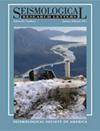在冰冷的南极东部高原中心的康考迪亚永久研究设施的一个新的后孔地震仪
IF 3.2
3区 地球科学
Q2 GEOCHEMISTRY & GEOPHYSICS
引用次数: 1
摘要
在南半球,海洋的普遍存在和进入陆地的困难导致地震台站的覆盖范围缩小,限制了我们对地球结构和大震源的详细了解。这种情况在南极大陆内部更为严重,那里目前只有两个永久地震台站可用。QSPA在南极和gccd)。CCD观测站建于21世纪初,配备了最先进的地面仪器,位于法国-意大利Concordia基地(75°S, 123°E),自2008年以来一直提供地震数据。然而,它有几个问题:拱顶被雪的静水压力变形,坚硬的波导捕获来自底部的人为噪声,导致1秒以下的强噪声,耦合缺陷限制了水平通道30秒以上的性能。为了确保CCD的连续性和提高其整体性能,我们于2014年开始计划在现场安装钻孔地震仪。在本文中,我们详细描述了CCD的这种改造,并给出了一些数据分析的例子。新型井眼传感器显示,与地面安装相比,短周期的干扰大大减弱(0.1秒时为- 20 dB),水平通道在长周期时的噪声水平较低(100秒时为- 8 dB)。所有组件的数据都低于0.1至0.2秒的标准噪声模型,这使该传感器成为世界上该带宽下最安静的传感器之一。在600秒周期内,我们观察到垂直分量上与大气压有关的扰动。尽管存在这些问题,新的CCD井眼站还是取得了成功,在所有时期的性能都好于预期。所产生的数据现在以gccd的形式分布在世界各地的数据中心。20 .我们鼓励科学界将这些数据用于需要南极地震仪的所有研究。本文章由计算机程序翻译,如有差异,请以英文原文为准。
A New Posthole Seismometer at Concordia Permanent Research Facility in the Heart of the Icy East Antarctic Plateau
Abstract In the Southern Hemisphere, the prevalence of oceans and the difficulty of access to land result in reduced coverage of seismological stations, limiting our detailed knowledge of Earth’s structures and of large earthquakes sources. This situation is exacerbated inside the antarctic continent, where only two permanent seismic stations are currently available (IU.QSPA at South Pole and G.CCD). The CCD station, built in early 2000s with state-of-the-art surface instrumentation and located at the French–Italian Concordia base (75° S, 123° E), has been providing seismological data since 2008. However, it suffers from several problems: the vault is deformed by the hydrostatic pressure of the snow, the firn waveguide traps anthropogenic noise from the base causing strong noise below 1 s, and a coupling defect limits the performance above 30 s on the horizontal channels. To ensure the continuity of CCD and to improve its overall performance, we started in 2014 to plan the installation of a borehole seismometer at the site. In this article, we describe in detail this renovation of CCD and some examples of data analysis. The new borehole sensor shows that short-period disturbances are largely attenuated (−20 dB at 0.1 s) compared to the surface installation and that the horizontal channels have a lower noise level at long periods (−8 dB at 100 s). Data for all components are below the standard noise model between 0.1 and 0.2 s, which makes this sensor one of the quietest installations in the world for this bandwidth. For periods >600 s we observe atmospheric pressure-related perturbations on the vertical component. Despite this problem, the new CCD borehole station is a success with better-than-expected performances at all periods <600 s. The data produced are now distributed in the world’s data centers as G.CCD.20 and we encourage the scientific community to use the data for all studies requiring seismograms from Antarctica.
求助全文
通过发布文献求助,成功后即可免费获取论文全文。
去求助
来源期刊

Seismological Research Letters
地学-地球化学与地球物理
CiteScore
6.60
自引率
12.10%
发文量
239
审稿时长
3 months
期刊介绍:
Information not localized
 求助内容:
求助内容: 应助结果提醒方式:
应助结果提醒方式:


